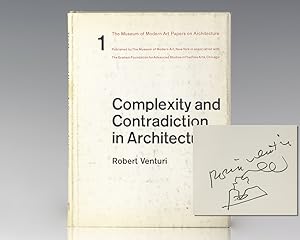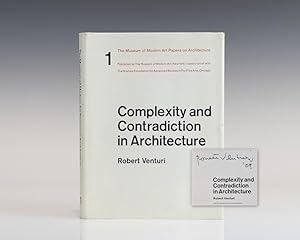complexity contradiction architecture von venturi robert vincent scully introduction (9 Ergebnisse)
Suchfilter
Produktart
- Alle Product Types
- Bücher (9)
- Magazine & Zeitschriften (Keine weiteren Ergebnisse entsprechen dieser Verfeinerung)
- Comics (Keine weiteren Ergebnisse entsprechen dieser Verfeinerung)
- Noten (Keine weiteren Ergebnisse entsprechen dieser Verfeinerung)
- Kunst, Grafik & Poster (Keine weiteren Ergebnisse entsprechen dieser Verfeinerung)
- Fotografien (Keine weiteren Ergebnisse entsprechen dieser Verfeinerung)
- Karten (Keine weiteren Ergebnisse entsprechen dieser Verfeinerung)
- Manuskripte & Papierantiquitäten (Keine weiteren Ergebnisse entsprechen dieser Verfeinerung)
Zustand Mehr dazu
- Neu (Keine weiteren Ergebnisse entsprechen dieser Verfeinerung)
- Wie Neu, Sehr Gut oder Gut Bis Sehr Gut (Keine weiteren Ergebnisse entsprechen dieser Verfeinerung)
- Gut oder Befriedigend (4)
- Ausreichend oder Schlecht (1)
- Wie beschrieben (4)
Einband
Weitere Eigenschaften
Sprache (1)
Preis
- Beliebiger Preis
- Weniger als EUR 20 (Keine weiteren Ergebnisse entsprechen dieser Verfeinerung)
- EUR 20 bis EUR 45
- Mehr als EUR 45
Gratisversand
Land des Verkäufers
Verkäuferbewertung
-
Complexity and Contradiction in Architecture
Verlag: Museum of Modern Art
Anbieter: ThriftBooks-Atlanta, AUSTELL, GA, USA
Paperback. Zustand: Fair. No Jacket. Readable copy. Pages may have considerable notes/highlighting. ~ ThriftBooks: Read More, Spend Less.
-
Complexity and Contradiction in Architecture
Verlag: Museum of Modern Art
Anbieter: ThriftBooks-Dallas, Dallas, TX, USA
Paperback. Zustand: Very Good. No Jacket. May have limited writing in cover pages. Pages are unmarked. ~ ThriftBooks: Read More, Spend Less.
-
Complexity and Contradiction in Architecture
Verlag: Museum of Modern Art
Anbieter: ThriftBooks-Atlanta, AUSTELL, GA, USA
Paperback. Zustand: Very Good. No Jacket. May have limited writing in cover pages. Pages are unmarked. ~ ThriftBooks: Read More, Spend Less.
-
Complexity and Contradiction in Architecture
Verlag: Museum of Modern Art
Anbieter: ThriftBooks-Atlanta, AUSTELL, GA, USA
Paperback. Zustand: Good. No Jacket. Pages can have notes/highlighting. Spine may show signs of wear. ~ ThriftBooks: Read More, Spend Less.
-
Complexity and Contradiction in Architecture
Verlag: Museum of Modern Art
Anbieter: ThriftBooks-Dallas, Dallas, TX, USA
Paperback. Zustand: Good. No Jacket. Pages can have notes/highlighting. Spine may show signs of wear. ~ ThriftBooks: Read More, Spend Less.
-
Complexity and Contradiction in Architecture.
Verlag: The Museum of Modern Art, New York, 1966
Anbieter: Raptis Rare Books, Palm Beach, FL, USA
Erstausgabe Signiert
First edition of this essential document of architectural literature. Octavo, original gray cloth, illustrated. Boldly signed by Robert Venturi and Vincent Scully on the title page. Fine in a near fine dust jacket. Introduction by Vincent Scully. Rare and desirable signed by both Venturi and Scully. As Venturi's "gentle manifesto for a nonstraightforward architecture," Complexity and Contradiction in Architecture expresses in the most compelling and original terms the postmodern rebellion against the purism of modernism. Three hundred and fifty architectural photographs serve as historical comparisons and illuminate the author's ideas on creating and experiencing architecture" (The New York Times).
-
Complexity and Contradiction in Architecture.
Verlag: The Museum of Modern Art, New York, 1966
Anbieter: Raptis Rare Books, Palm Beach, FL, USA
Erstausgabe Signiert
First edition of this essential document of architectural literature. Octavo, original gray cloth, illustrated. Boldly signed by Robert Venturi who has added a drawing of his mother's house on the dedication page. Fine in a near fine dust jacket. Introduction by Vincent Scully. As Venturi's "gentle manifesto for a nonstraightforward architecture," Complexity and Contradiction in Architecture expresses in the most compelling and original terms the postmodern rebellion against the purism of modernism. Three hundred and fifty architectural photographs serve as historical comparisons and illuminate the author's ideas on creating and experiencing architecture" (The New York Times).
-
Complexity and Contradiction in Architecture.
Verlag: The Museum of Modern Art, New York, 1966
Anbieter: Raptis Rare Books, Palm Beach, FL, USA
Erstausgabe Signiert
First edition of this essential document of architectural literature. Octavo, original gray cloth, illustrated. Presentation copy, inscribed by the author on the front free endpaper, "To Al, Friendship and respect Bob Venturi." FineÂin a near fine dust jacket with a touch of shelfwear. As Venturi's "gentle manifesto for a nonstraightforward architecture," Complexity and Contradiction in Architecture expresses in the most compelling and original terms the postmodern rebellion against the purism of modernism. Three hundred and fifty architectural photographs serve as historical comparisons and illuminate the author's ideas on creating and experiencing architecture" (The New York Times).
-
Complexity and Contradiction in Architecture.
Verlag: The Museum of Modern Art, New York, 1966
Anbieter: Raptis Rare Books, Palm Beach, FL, USA
Erstausgabe Signiert
First edition of this essential document of architectural literature. Octavo, original gray cloth, illustrated. Signed and dated by Robert Venturi on the title page. FineÂin a near fine dust jacket with a touch of shelfwear. As Venturi's "gentle manifesto for a nonstraightforward architecture," Complexity and Contradiction in Architecture expresses in the most compelling and original terms the postmodern rebellion against the purism of modernism. Three hundred and fifty architectural photographs serve as historical comparisons and illuminate the author's ideas on creating and experiencing architecture" (The New York Times).






